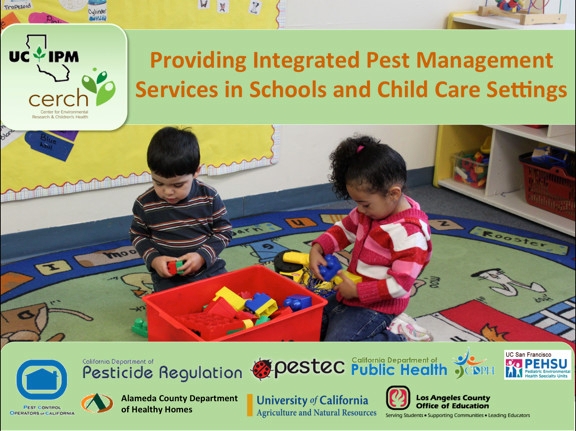Posts Tagged: children
Online course helps control pests, protect children
Free UC IPM course helps pest management professionals understand the Healthy Schools Act and provide IPM services to schools and child care centers
Pest management professionals can learn about the requirements of California's Healthy Schools Act by taking a free online course provided by the UC Statewide Integrated Pest Management Program (UC IPM), part of University of California Agriculture and Natural Resources (UC ANR).
To minimize children's exposure to pesticides, California requires pest control operators providing services in schools and licensed child care centers to comply with a series of laws called the Healthy Schools Act. The laws promote integrated pest management (IPM) in public K–12 schools and licensed private child care centers.
The free course Providing Integrated Pest Management Services in Schools and Child Care Settings explains what the Healthy Schools Act requires of schools, child care centers and pest control companies when managing pests in these environments.
"Taking the online course makes it easier to understand and comply with the laws," said Andrew Sutherland, UC ANR Cooperative Extension IPM advisor. "Pest management professionals can take the course at their convenience. It tells them everything they need to know about the Healthy Schools Act and IPM in order to do business with a school or child care center."
The course also includes a section on how companies can prosper by incorporating IPM principles and practices into their businesses.
"This is an opportunity for operators to take their businesses to the next level by adopting IPM practices," Sutherland said. "IPM effectively and efficiently manages pests, builds professionalism within providers, and captures value for the customer while minimizing pesticide applications, pesticide exposures and associated negative impacts on children's health, the environment and the larger community."
Licensed pest-management professionals can receive continuing education units by completing the online course: one "Rules and Regulations" and one "IPM" from the Structural Pest Control Board; and one "Laws and Regulations" and one "Other" from the Department of Pesticide Regulation.
UC Berkeley's Center for Environmental Research and Children's Health is developing a database of individuals who complete the course so that schools and child care centers can connect with pest control providers who are familiar with IPM and the Healthy Schools Act.
The training module was developed by Sutherland and collaborators at UC Berkeley and UC San Francisco, with input from California pest management professionals and child care providers.
To take the free Providing Integrated Pest Management Services in Schools and Child Care Settings course, see the UC IPM website http://ucanr.edu/ipm4schools.
This project was funded by the California Department of Pesticide Regulation Pest Management Alliance Program. For more information about the Healthy Schools Act, visit the California Department of Pesticide Regulation's School IPM web page http://apps.cdpr.ca.gov/schoolipm.
An initiative to maintain and enhance healthy families and communities is part of the UC Agriculture and Natural Resources Strategic Vision 2025.
Kids drop pounds, eat more veggies with nutrition program
The percentage of overweight or obese children in test schools dropped from 56 percent to 38 percent over the course of a single school year, thanks to a new nutrition program developed and tested in the classroom by nutrition researchers at the University of California, Davis.
The new program fits into the new Common Core educational standards.
"The education component of this program is intended to help children develop nutrition-related problem solving skills," said co-author Jessica Linnell, a senior doctoral candidate in the UC Davis Department of Nutrition. "We think that these skills, combined with knowledge about foods, may be critical in order for children to make healthy choices."
Researchers say the program could be adopted nationally at little cost to schools. The program was pilot-tested for this study in schools located in Sacramento and Stanislaus counties. Study findings were reported recently during the Experimental Biology 2014 meeting.
"When we designed the study, we anticipated short-term outcomes such as kids having more knowledge of nutrition or being able to identify more vegetables," said Rachel Scherr, assistant project scientist in the UC Davis Department of Nutrition and one of the study's lead investigators. "We always had a long-term goal of decreasing body mass index, but we didn't anticipate that it would happen in such a short timeframe, so we are thrilled."
In a randomized control study, the researchers found that fourth-graders who participated in the nutrition program ate substantially more vegetables and lowered their body mass index during the school year that the nutrition program was implemented.
Senior author Sheri Zidenberg-Cherr, a Cooperative Extension specialist In the Department of Nutrition and co-director of the UC Davis Center for Nutrition in Schools, said that the project could not have been possible without the work of a highly interdisciplinary team, including collaborators from University of California Agriculture and Natural Resources; the UC Davis departments of Nutrition, Human Ecology, Population Health and Reproduction, and Plant Sciences; the UC Davis Health System, Betty Irene Moore School of Nursing, Foods for Health Institute and Agricultural Sustainability Institute; and the University of Utah Department of Physics and Astronomy.
The study was funded by a UC Division of Agriculture and Natural Resources Competitive Grant.

Fourth-graders who participated in the nutrition program ate more vegetables.

